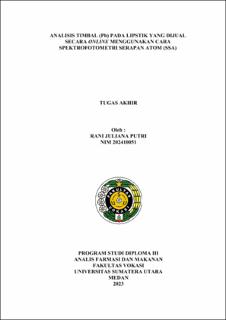| dc.description.abstract | Background: Cosmetics are preparations intended for use on the outside of the
human body. The most widely used cosmetics product is lipstick. Some lipsticks
have been found to contain toxic ingredients such as lead metal (Pb). The presence
of lead (Pb) can make lipstick resistant to air oxidation and waterproof, because
lead (Pb) has properties that are difficult to dissolve in water. If heavy metal lead
(Pb) is absorbed by the skin, it will enter the blood and attack organs, causing
various diseases. Lead (Pb) can attack the nervous system, urinary system, gastrointestinal
system, cardiovascular system, reproductive system, endocrine system
and is carcinogenic in high doses.
Objective: To determine the levels of lead metal (Pb) in lipstick and compare with
the requirements set by the Food and Drugs Administration number 12 of 2019.
Method: Lipstick samples are obtained from online shopping applications then the
samples are acidically deconstructed by adding 10 ml of concentrated HNO3, then
heated to a volume of approximately 10 ml followed by the addition of 5 ml of
concentrated HCIO4 heated again until the sample solution is clear, heating is
continued for approximately 30 minutes the cool the sample solution the filtered
with filter paper, the filtrate is placed in a 100 ml volumetric flask, distilled water
is added to the limit mark, the test solution is read using atomic absorption
spectrophotometry at a wavelength of 217 nm.
Result: The result showed that the average level of lead metal (Pb) in lipstick that
is not registered with the food and drug administration is 1,7226 mg/kg and the
average level of lead metal (Pb) in lipstick registered with the food and drug
administration is 2,1534 mg/kg.
Conclusion: Based on the research that has been done, it can be concluded that the
average level of lead metal (Pb) in lipstick meets the requirements set by the food
and drugs administration number 12 of 2019, which does not exceed 20 mg/kg. | en_US |





